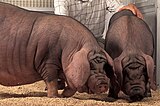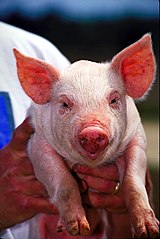
A landrace is a domesticated, locally adapted, often traditional variety of a species of animal or plant that has developed over time, through adaptation to its natural and cultural environment of agriculture and pastoralism, and due to isolation from other populations of the species. Landraces are distinct from cultivars and from standard breeds.

The Ukrainian Riding Horse or Ukrainian Saddle Horse is a modern Ukrainian breed of warmblood sport horse. Breeding began in the years after the Second World War at the stud farm of Dnipropetrovsk in central Ukraine – at that time in the USSR – and later expanded to three other state stud farms. It derives from cross-breeding of Hanoverian, Thoroughbred and Trakehner stallions with local mares or with Hungarian Furioso, Gidran Arab or Nonius mares. It incorporates the last bloodlines of the extinct Orlov-Rostopchin or Russian Saddle Horse. It was bred to compete in show jumping, three-day eventing and dressage, but is also suitable as a general riding horse.

Vietnamese Pot-bellied is the exonym for the Lon I or I pig, an endangered traditional Vietnamese breed of small domestic pig.

The Brangus is an American hybrid breed of beef cattle derived from cross-breeding of American Angus and Brahman stock. Registered animals have 5/8 Angus and 3/8 Brahman parentage. A similar hybrid breed, the Australian Brangus, was separately developed in Australia from about 1950.
Animal breeding is a branch of animal science that addresses the evaluation of the genetic value of livestock. Selecting for breeding animals with superior EBV in growth rate, egg, meat, milk, or wool production, or with other desirable traits has revolutionized livestock production throughout the entire world. The scientific theory of animal breeding incorporates population genetics, quantitative genetics, statistics, and recently molecular genetics and is based on the pioneering work of Sewall Wright, Jay Lush, and Charles Henderson.

The Dorset Horn is an endangered British breed of domestic sheep. It is documented from the seventeenth century, and is highly prolific, sometimes producing two lambing seasons per year. Among British sheep, it is the only breed capable of breeding throughout the winter.
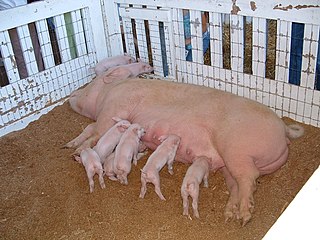
The American Yorkshire is an American breed of large domestic pig. It is the most numerous pig breed in the United States. It derives from pigs of the British Large White or Yorkshire breed imported from the United Kingdom or from Canada at various times from about 1830 to the mid-twentieth century.

The Kinder is an American breed of domestic goat. It originated on a farm in Snohomish, Washington, where in about 1985 an American Pygmy buck was cross-bred with Nubian does. The resulting stock was selectively bred to create a compact but well-muscled goat, suitable both for milk and for meat production. A herd-book was started in 1988; by 2006 about three thousand head had been registered.
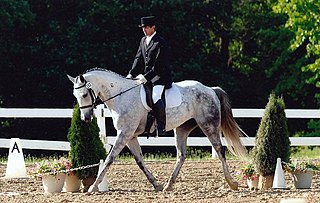
The Hungarian Sport Horse, Hungarian: 'Magyar sportló', is a modern Hungarian breed of sporting horse. Like the Furioso-North Star, the Gidran, and the Nonius, it was developed at the Hungarian State Stud Mezőhegyes, in Békés county in the Southern Great Plain region of south-eastern Hungary. At the end of 2012, the total number for the breed was reported to be 1091. The breeders' association is the Magyar Sportlótenyésztők Országos Egyesülete, or Association of Hungarian Sporthorse Breeders.

Kalmyk cattle is a breed of beef cattle of the former Soviet Union, now found in the Russian Federation, in Kazakhstan and in Tajikistan. It is believed to have originated in Dzungaria, and to have been brought into south-eastern Russia by migrating Kalmyks in the seventeenth century.
The Semirechensk is a Kazakh breed of domestic pig. It was purpose-bred in the twentieth century in the Kazakh Soviet Socialist Republic of the Soviet Union. The breeding stock was principally Large White, with some admixture of Siberian Kemerovo and a small proportion of wild boar.

The Appenzell, French: Chèvre d’Appenzell, German: Appenzellerziege, is a rare and endangered indigenous breed of white domestic goat from Switzerland. It originates in the "half-cantons" of the historic Appenzell region, Appenzell Ausserrhoden and Appenzell Innerrhoden, and has spread into the neighbouring Canton of St. Gallen.

The Asil or Aseel is an Indian breed or group of breeds of game chicken. It is distributed in much of India, particularly in the states of Tamil Nadu, Andhra Pradesh, Chhattisgarh and Odisha; it has been exported to several other countries. Similar fowl are found throughout much of Southeast Asia.
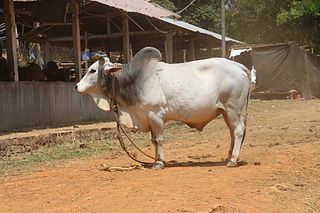
The Malvi or Malavi, also known as Manthani or Mahadeopuri, is breed of zebu cattle from the Malwa plateau in western Madhya Pradesh, in central India. It is a good draught breed; the milk yield of the cows is low.

The Finnish Ayrshire is a Finnish breed of dairy cattle. It derives from Scottish Ayrshire stock imported to Finland between about 1847 and 1923. It is the most numerous dairy breed of the country, constituting approximately 61% of the dairy herd.
The Vištinės or Vishtines is a Lithuanian breed of domestic goose. It was developed by selective breeding of traditional Lithuanian geese, with some later influence from the East Prussian, Emden and Pomeranian breeds.

The Onagadori is a historic Japanese breed of chicken, characterised by an exceptionally long tail. It was bred in the seventeenth century in Kōchi Prefecture, on Shikoku island in southern Japan, and was designated a Japanese National Natural Treasure in 1952. It is one of the ancestors of the German Phoenix breed.
The Finarda is a breed of large domestic sheep from the regions of Lombardy and Piemonte in northern Italy. It is heavy breed raised mainly for meat, although it also yields 4–6 kg of wool per year. It results from cross-breeding the Bergamasca and Biellese breeds. It is one of the forty-two autochthonous local sheep breeds of limited distribution for which a herdbook is kept by the Associazione Nazionale della Pastorizia, the Italian national association of sheep-breeders. However, in 2008 the herdbook was empty, and may in fact never have been activated. Most data for the breed dates from 1983.

The Bleue du Nord is a French breed of dual-purpose cattle from the former region of Nord-Pas-de-Calais in the north-east of the country, on the border with Belgium. It shares the origins of the Belgian Blue, but unlike that breed is selectively bred both for meat and for dairy use. The double-muscling characteristic of the Belgian Blue, caused by a genetic myostatin deficiency, is present also in the Bleue du Nord, but to a limited and controlled extent.
The Dutch Improved Red Pied, Dutch: Verbeterd Roodbont, is a recently-developed Dutch breed of beef cattle. It derives from the dual-purpose Meuse-Rhine-Issel breed, and is characterised by a high incidence of the double-muscling gene. A breed association was started in 1988.


